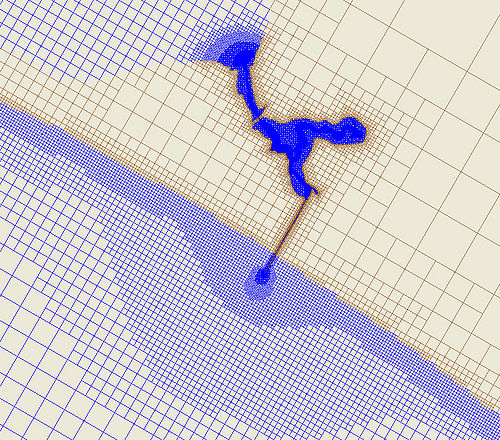East Harbor
UNDER CONSTRUCTION

East Harbor is an example of a tidally-restricted estuary located north of Truro, Massachusetts, on Cape Cod. The site consists of three main components; Pilgrim Lake, Moon Pond and Salt Meadows. The study will focus on restoring tidal exchange between Cape Cod Bay and Pilgrim Lake/Moon Pond components. The Harbor is connected to Cape Cod Bay by a 2.2 m2 area by 200-m long culvert leading to a poorly flushed marsh area which in turn empties into a lake and marsh system. The original inlet located at the north end of the estuary (Figure 1a) was closed by the construction of a dike in 1869. The motivation behind this closure was to reduce or eliminate the erosion occurring on the seaward side of East Harbor and later provided railroad access to Provincetown (USACE, 1868; NOAA, 2006) Tidal access to the estuary was relocated at the southern end of the estuary with a fixed culvert with dimensions 1.1 m by 2 m (Figure 1b). This closure significantly changed hydrodynamics of the system and sediment transport on Cape Cod Bay and within the estuary.
Project Objectives
The goal of this study is to evaluate alternatives for increasing the tidal range in East Harbor, which will improve tidal flushing and water quality. The CMS model will be used to determine not only the effect a variety of inlet configurations will have on the system in terms of flushing but also examine the nearshore response. Preliminary analysis of the site using a 1D Escoffier – Inlet Equilibrium model (CEA; Seabergh and Kraus ) indicated the stable equilibrium for a natural inlet reopened at the site is approximately 340 m2, and the minimum cross-section is 10 m2. However, the present land ownership limitations at the site are a maximum width of 23 m.
Questions to be answered by the CMS Modeling study:
1) How big does the inlet need to be to stay open/stable?
2) What is the appropriate inlet location and size?
3) What is the worst case volume of sand would need to be bypassed?
4) What are the likely dimensions of potential structures?
Model Setup

Since the existing culvert dimensions are 1.1 m x 2 m oval concrete pipe, the telescoping grid will allow for very small grid cell size (0.5 m) while maintaining reasonable computational run time.
No existing wave data has been identified so all wave generation is performed through the CMS-Wave model from wind wave generation.
Table 1. Sediment transport and morphology parameters in the CMS
| Parameter | Value |
|---|---|
| Formulation | |
| Sediment Transport Formula | |
| Bed Load Scaling Factor | |
| Suspended Load Scaling Factor | |
| Sediment Porosity | |
| Bed Slope Coefficient | |
| Morphologic Acceleration Factor | |
| Total Load Adaptation Length Method | |
| Adaptation Length |
Validation
Discussion
- For a definition of the goodness of fit statistics see Goodness of fit statistics
References
- Seabergh, W.C., and Kraus, N.C. (1997). “PC program for coastal inlet stability analysis using Escoffier method,” Coastal Engineering Technical Note CETN IV-11, U.S. Army Engineer Research and Development Center, Vicksburg, MS, 7 p
- Headquarters, U.S. Army Corps of Engineers. (1868). “Provincetown Harbor, Massachusetts.” Annual Report of the Secretary of War: Appendix RS, 828-829.
- Watts, I. M., Rosati, J. D., Borelli, M. (2010) "Re-Establishing a Historical Inlet at East Harbor, Cape Cod" Coastal Sediments '11 Conference Proceedings, In Press